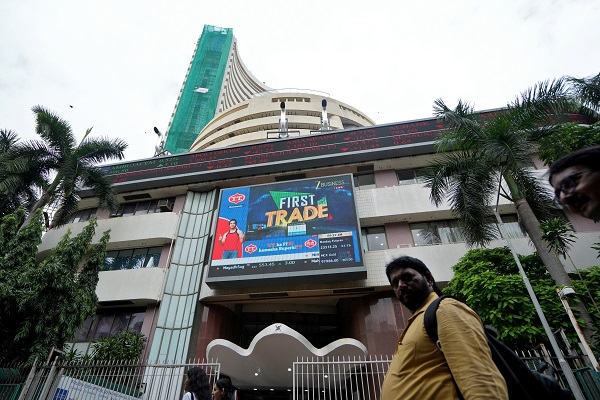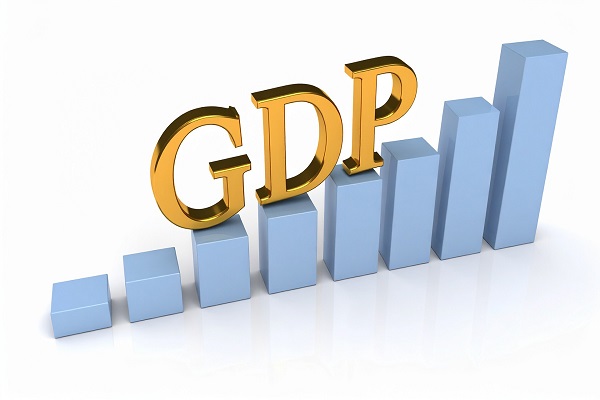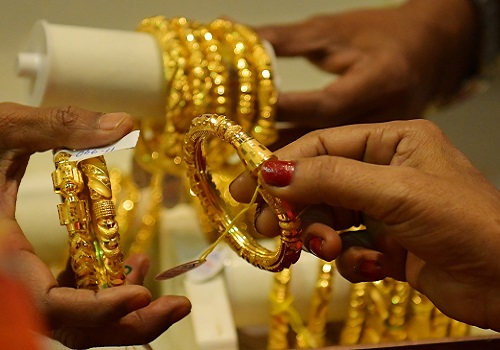Jeera trading range for the day is 25060-26320 - Kedia Advisory

Gold
Gold rose by 1.25% to settle at Rs.72,824 as U.S. inflation data showed mixed signals for producer prices in August. The Producer Price Index (PPI) increased by 0.2%, slightly above expectations of 0.1%, driven by higher wholesale inflation which rose 1.7% over the last year, below the 1.8% forecast. Meanwhile, the European Central Bank cut its interest rate by 0.25% to 3.5%, signaling a potential easing of monetary policy in response to softer economic conditions. In the U.S., the number of unemployment benefit claims rose by 2,000 to 230,000 for the week ending September 7th, further reflecting the ongoing softening of the labor market, as highlighted by weak payrolls data for August. On the global gold demand front, Indian discounts surged to a seven-week high due to rising prices, with dealers offering a discount of up to $13 an ounce. Chinese demand remained muted amid record-high prices, with dealers offering discounts of up to $8. In other parts of Asia, Hong Kong dealers offered gold at a $0.50 to $1 premium, while Singapore and Japan saw premiums ranging between par value and $2.20. Technically, the market witnessed fresh buying with a 3.53% increase in open interest, leading to a Rs.897 price rise. Gold is currently supported at Rs.72,170, with potential for a test of Rs.71,515 on the downside. Resistance is likely at Rs.73,180, and a move beyond this could push prices to test the Rs.73,535 level.
Trading Ideas:
* Gold trading range for the day is 71515-73535.
* Gold gains after the latest data shows U.S. producers saw mixed price pressures last month.
* The headline Producer Price Index (PPI) rose 0.2% in August, following July’s 0.1% increase.
* The number of people claiming unemployment benefits in the US rose by 2,000 from the previous week to 230,000
Silver
Silver prices surged by 3.13% to settle at Rs.87,095 on expectations of a U.S. Federal Reserve rate cut at the upcoming meeting. U.S. consumer prices rose marginally in August, with underlying inflation showing persistence, suggesting the Fed may deliver a smaller 25-basis-point rate cut. Wholesale prices in the U.S. increased by 0.2% month-over-month, exceeding the forecast of 0.1%, further supporting the view of a smaller rate reduction. Market sentiment now sees an 85% probability of a 25 bps cut, while the chances of a larger 50 bps cut have decreased to 15%, according to the CME’s FedWatch Tool. Meanwhile, the European Central Bank lowered its interest rates, citing lower inflation and slowing economic growth, marking its second rate cut in three months. In India, silver imports are expected to nearly double this year, driven by rising demand from the solar panel and electronics industries, as well as investor interest in silver over gold. India’s silver imports in the first half of 2024 surged to 4,554 tons from just 560 tons a year ago, reflecting the stockpiling by industrial buyers to hedge against rising prices. Technically, the silver market is experiencing short covering, with open interest dropping by -13.68% to settle at 26,489 contracts, while prices rose by Rs.2,645. Silver is now finding support at Rs.85,280, and if it falls below this level, it could test Rs.83,470. On the upside, resistance is expected at Rs.88,100, with the potential to test Rs.89,110 if breached.
Trading Ideas:
* Silver trading range for the day is 83470-89110.
* Silver gains on expectations of a U.S. Federal Reserve rate cut next week
* Wholesale prices in the US increased 0.2% month-over-month in August 2024, above forecasts of 0.1%.
* Markets now see an 85% probability that the Fed will reduce rate by 25 basis points at the upcoming meeting, with just a 15% chance of a larger 50 bps reduction.
Crudeoil
Crude oil prices surged by 2.09% to settle at Rs.5,809, driven by concerns over Hurricane Francine's impact on U.S. oil production. The hurricane is expected to disrupt around 1.5 million barrels of oil output, reducing September production in the Gulf of Mexico by approximately 50,000 barrels per day (bpd). However, gains were tempered by a weaker demand outlook. The International Energy Agency (IEA) cut its 2024 global oil demand growth forecast by 70,000 bpd to 900,000 bpd, citing a slowdown in Chinese demand due to economic challenges and increased adoption of electric vehicles. Chinese demand is now projected to grow by just 180,000 bpd in 2024. U.S. crude inventories increased by 0.833 million barrels for the week ending September 6, 2024, slightly below market expectations of a 1 million barrel rise. Gasoline and distillate stockpiles also rose, with gasoline increasing by 2.311 million barrels and distillates by 2.308 million barrels, both exceeding forecasts. In contrast, crude stocks at the Cushing delivery hub declined by 1.704 million barrels, signaling tighter supply in certain areas. On the global front, China's crude oil imports in August fell 7% year-on-year to 49.10 million metric tons, though they rebounded from July's lows. Technically, crude oil is experiencing short covering, as evidenced by a 17.55% drop in open interest. Prices rose by Rs.119, with support at Rs.5,707 and potential for a test of Rs.5,605. Resistance is likely at Rs.5,889, and a move above this level could see prices testing ?5,969.
Trading Ideas:
* Crudeoil trading range for the day is 5605-5969.
* Crude oil rose spurred by concern over Hurricane Francine's impact on U.S. output
* IEA cuts 2024 oil demand growth forecast on China slowdown
* Global oil supply rises with higher production from non-OPEC countries like the US, Guyana, and Brazil.
Naturalgas
Natural gas prices surged by 4.43% to settle at Rs.200.3, supported by rising seasonal demand, record LNG exports, and increased adoption of natural gas in China’s transportation sector. Despite U.S. production hitting record highs, the anticipated growth in demand, especially from power generation and industrial sectors, is expected to tighten market conditions. While inventories remain slightly above average, potential supply disruptions from Gulf Coast storms and increasing export volumes could deplete stockpiles, adding further upward pressure on prices. According to LSEG, U.S. gas output in the Lower 48 states averaged 102.1 billion cubic feet per day (bcfd) in September, down from 103.2 bcfd in August. Demand, including exports, is forecast to rise from 99.6 bcfd this week to 100.1 bcfd next week, while supply is expected to dip slightly. The U.S. Energy Information Administration (EIA) also projected that U.S. natural gas production will decline in 2024 to 103.4 bcfd, while domestic gas consumption will rise to a record 89.9 bcfd before easing in 2025. In storage, U.S. utilities added 40 billion cubic feet of gas during the week ending September 6, 2024, below market expectations of a 49 bcf increase. This brought total stockpiles to 3,387 bcf, which is 198 bcf higher than last year and 296 bcf above the five-year average. Technically, the market is experiencing short covering, with open interest dropping by -7.27% to settle at 30,861 contracts as prices rose by Rs.8.5. Natural gas is now finding support at Rs.191.7, with a potential test of Rs.183 on the downside. Resistance is seen at Rs.205.1, and if breached, prices could test Rs.209.8.
Trading Ideas:
* Naturalgas trading range for the day is 183-209.8.
* Natural gas gains supported by rising seasonal demand, record LNG exports
* US utilities added 40 billion cubic feet of gas into storage during the week
* Despite US production reaching record highs, anticipated demand growth, is set to tighten market conditions.
Copper
Copper prices rose by 0.81% to settle at Rs.798.65, driven by mixed production data and a fluctuating global market. Chile's state miner Codelco saw a significant production drop of 10.7% year-on-year in July, producing 111,400 metric tons of copper. However, the BHP-controlled Escondida mine increased its output by 29% to 106,500 tons, while the Collahuasi mine, jointly operated by Glencore and Anglo American, saw a 6% decrease to 47,000 tons. Meanwhile, China's manufacturing activity slumped to a six-month low in August, leading to weaker demand forecasts from the world's top copper consumer. Chile's copper commission, Cochilco, lowered its 2024 copper price forecast to $4.18 per pound from $4.30, citing global economic weaknesses, but maintained its 2025 projection at $4.25 per pound. Cochilco also expects Chile's copper production to increase by 3% in 2024, although still short of earlier estimates. Globally, the refined copper market showed a surplus of 95,000 metric tons in June, up from 63,000 tons in May, according to the International Copper Study Group (ICSG). China's unwrought copper imports fell to a 16-month low in August, down 12.3% year-on-year, reflecting weaker demand. Technically, the market experienced short covering, with open interest dropping by 6.1%. Prices rose by Rs.6.45, with support at Rs.794, and a test of Rs.789.4 is possible if prices drop. On the upside, resistance is seen at Rs.803.2, and a move above this level could push prices towards Rs.807.8.
Trading Ideas:
* Copper trading range for the day is 789.4-807.8.
* Copper gains as copper output from Chile's Codelco slides nearly 11% in July
* Chile's state-owned copper commission Cochilco lowered its forecast for the average price of copper in 2024 to $4.18 per pound
* China's unwrought copper imports slid in August to a 16-month low, customs data showed.
Zinc
Zinc prices rose by 1.99% to settle at Rs.264.45, driven by optimism over a potential interest rate cut from the U.S. Federal Reserve. China's export growth moderated in August 2024, increasing by 4.6% year-on-year, while imports rose by 2.5%, exceeding expectations but slowing from the previous month. On the supply front, zinc inventories in LME warehouses increased to 217,575 tonnes by the end of August, with Spain-origin zinc making up the largest portion at 38.7%, followed by India-origin zinc at 63,050 tonnes and Australia-origin zinc at 21,875 tonnes. The global zinc market surplus narrowed to 8,700 metric tons in June from 44,000 tons in May, reflecting tightening supply. For the first half of 2024, the surplus was 228,000 tons, a significant reduction from the 452,000 tons surplus in the same period last year. China's refined zinc production in July 2024 declined by 10.3% month-on-month and 11.15% year-on-year to 489,600 metric tons, largely due to heavy rainfall in Sichuan and unexpected production cuts in Yunnan, Guangdong, and Guangxi. Smelters in Henan, Inner Mongolia, and Gansu also experienced disruptions due to maintenance. Technically, the zinc market saw fresh buying activity, with open interest rising by 1.67% to 2,129 contracts as prices increased by Rs.5.15. Zinc is currently finding support at Rs.261.3, with a potential test of Rs.258 if breached. On the upside, resistance is expected at Rs.266.3, and prices could test Rs.268 if resistance is broken.
Trading Ideas:
* Zinc trading range for the day is 258-268.
* Zinc gains amid optimism surrounding a likely interest rate cut from the Federal Reserve this month.
* Exports from China increased by 4.6% year-on-year in August 2024, moderating from a 7% rise in July.
* Total open-tonnage volumes of zinc in LME warehouses amounted to 217,575 tonnes on August 30, up 2.6% end of July
Aluminium
Aluminium prices rose by 0.87% to settle at Rs.224.95, driven by signs of recovering demand as the market enters its traditional peak season. Consumption is gradually improving, and a turning point in inventory reduction may have been reached. LME aluminium inventories have dropped by 22% over the past three months, reaching 877,950 tons, the lowest since May 8. Meanwhile, aluminium inventories monitored by the Shanghai Futures Exchange fell by 1.4%, indicating tightening supply. On the global front, China's aluminium output surged by 6% year-on-year in July to 3.68 million metric tons, marking the highest monthly output since 2002. The yearly increase was attributed to new projects coming online in Inner Mongolia, alongside strong production from smelters in other key regions. Globally, primary aluminium output rose by 2.4% in July, reaching 6.194 million metric tons, with China contributing significantly to the rise. However, concerns over global economic growth and weak Chinese manufacturing data capped further price gains. China's manufacturing activity fell to a six-month low in August, with factory owners struggling for orders. Despite the production increases, the market remains wary due to the ongoing economic uncertainties. Technically, aluminium is witnessing short covering, as open interest fell by 7.66%. Prices increased by Rs.1.95, with immediate support at Rs.224.1 and a potential test of Rs.223.1 on the downside. Resistance is expected at Rs.226, and a move above this level could push prices towards Rs.226.9.
Trading Ideas:
* Aluminium trading range for the day is 223.1-226.9.
* Aluminium gains as demand side is entering the traditional peak season, consumption is gradually recovering
* Aluminium stocks were broadly unchanged, and on-warrant stocks pushed up to 345,300 tonnes in August
* Aluminium inventories in warehouses monitored by the Shanghai Futures Exchange fell 1.4% from last Friday
Cottoncandy
Cottoncandy prices settled up by 0.5% at ?58,610, supported by concerns over lower acreage in the current kharif season. Cotton acreage has dropped by 9% to 110.49 lakh hectares compared to 121.24 lakh hectares last year, as many farmers have shifted to other crops due to lower yields and high production costs. The Cotton Association of India (CAI) expects total acreage this year to be around 113 lakh hectares, down from 127 lakh hectares in the previous year. Exports to Bangladesh have also contributed to tightening cotton supply, with exports increasing from 15 lakh bales to 28 lakh bales this year due to strong demand. India's cotton production and consumption are both estimated at 325 lakh bales for 2023-24. With imports at 13 lakh bales, the gap of 15 lakh bales will be met by drawing down last year's stock. Currently, spinning mills hold around 25 lakh bales, ginners 15 lakh bales, and the Cotton Corporation of India has about 20 lakh bales, leaving 70 lakh bales available for consumption through September. On the global front, cotton production and consumption for 2024/25 have been revised downward, particularly in the U.S. and India, leading to a reduction in global ending stocks by 5 million bales to 77.6 million. Technically, the market witnessed short covering as open interest remained unchanged. Cottoncandy is seeing support at Rs.58,300, with a potential test of Rs.58,000 if breached. Resistance is expected at Rs.58,850, and prices could test Rs.59,100 if resistance is broken.
Trading Ideas:
* Cottoncandy trading range for the day is 58000-59100.
* Cotton gains as acreage in cotton is down by around 9 percent
* CAI predicts acreage to be around 113 lh this year, up from 127 lh in the previous year.
* Global cotton production cut by 2.6 million bales; lower in US, India.
* In the global 2024/25 cotton balance sheet, beginning stocks, production and consumption are increased.
Turmeric
Turmeric prices fell by 2.96% to settle at Rs.13,626, driven by news of increased sowing. In Indonesia, dry weather has accelerated the turmeric harvest, adding to the pressure on prices. However, the downside was limited by tighter supplies in the market and buying interest from stockists. Some support was also seen as farmers held back stocks in anticipation of a further price rise. In addition, low export demand and rising sowing acreage could contribute to further price declines. Sowing reports suggest that turmeric sowing on the Erode line has doubled compared to last year, and Maharashtra, Telangana, and Andhra Pradesh are seeing 30-35% higher sowing. Estimates suggest that turmeric sowing in India has increased from 3-3.25 lakh hectares last year to 3.75-4 lakh hectares this year. Despite higher sowing, the expected turmeric crop for the upcoming season is estimated to be around 70-75 lakh bags, compared to the 80-85 lakh bags produced last year. Turmeric exports dropped 19.52% between April-June 2024, with 46,497.99 tonnes exported, compared to 57,775.26 tonnes in the same period of 2023. Imports, however, surged by 485.40% during the same period. In Nizamabad, a key spot market, prices gained slightly by 0.1% to Rs.14,364. Technically, the market is undergoing long liquidation, with a 2.49% drop in open interest. Prices fell by Rs.416, with support at Rs.13,410 and potential downside testing Rs.13,194. On the upside, resistance is likely at Rs.13,966, and a move above could see prices testing Rs.14,306.
Trading Ideas:
* Turmeric trading range for the day is 13194-14306.
* Turmeric ended with losses amid news of increased sowing.
* However downside seen limited amid tighter supplies in the market and emerging buying from stockists.
* In Indonesia, dry weather has accelerated harvesting, which is currently at peak levels.
* In Nizamabad, a major spot market, the price ended at 14364 Rupees gained by 0.1 percent.
Jeera
Jeera prices increased by 0.49% to settle at Rs.25,695, driven by strong domestic and export demand along with limited global supplies. Farmers are holding back their stocks, anticipating better prices, which further supported the market. However, the upside remains limited due to expectations of higher production. Jeera production in India is projected to rise by 30% this season, reaching 8.5-9 lakh tonnes due to significant increases in cultivation areas. Gujarat's sowing area has expanded by 104%, while Rajasthan saw a 16% increase. On the global front, production has surged in countries like China, Syria, Turkey, and Afghanistan, where higher prices last season incentivized increased sowing. China's output rose to 55-60 thousand tons, while Turkey expects 12-15 thousand tons. Afghanistan’s production could double, depending on weather conditions. These increases are likely to put pressure on cumin prices in the coming months. India's cumin exports rose 46.56% during April-June 2024, reaching 73,770.58 tonnes compared to the same period in 2023. Despite a 29.12% month-on-month decline in June 2024, exports were still 60.13% higher than in June 2023. The favorable price outlook and increased sowing are expected to drive further growth in exports for the remainder of 2024. India’s Meteorological Department forecasts above-average rainfall in August and September, which should further support jeera production and the agricultural sector overall. Technically, the market saw fresh buying with a 2.36% increase in open interest. Jeera is finding support at Rs.25,390, with potential downside testing at Rs.25,060, while resistance is expected at Rs.26,060, with the possibility of testing Rs.26,320 if resistance is breached.
Trading Ideas:
* Jeera trading range for the day is 25060-26320.
* Jeera gains amid robust domestic and export demand besides tight global supplies.
* However upside seen limited as the expectation of higher production weighed on the prices.
* Turkey anticipates producing 12-15 thousand tons, while Afghanistan's output could double.
* In Unjha, a major spot market, the price ended at 25587.1 Rupees dropped by -0.05 percent.
Views express by all participants are for information & academic purpose only. Kindly read disclaimer before referring below views
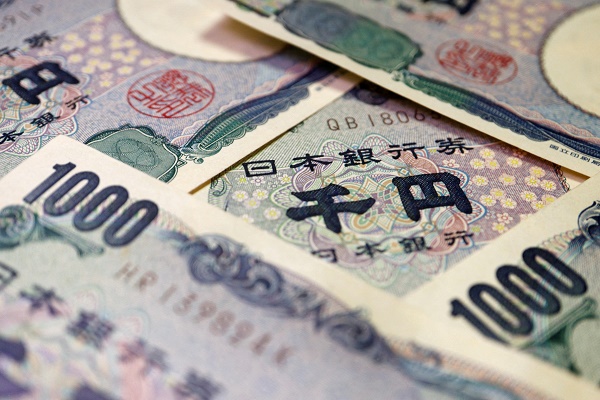

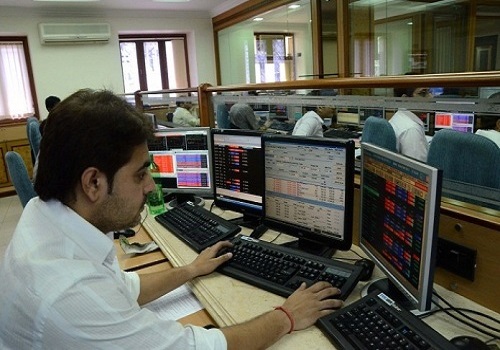
.jpg)
